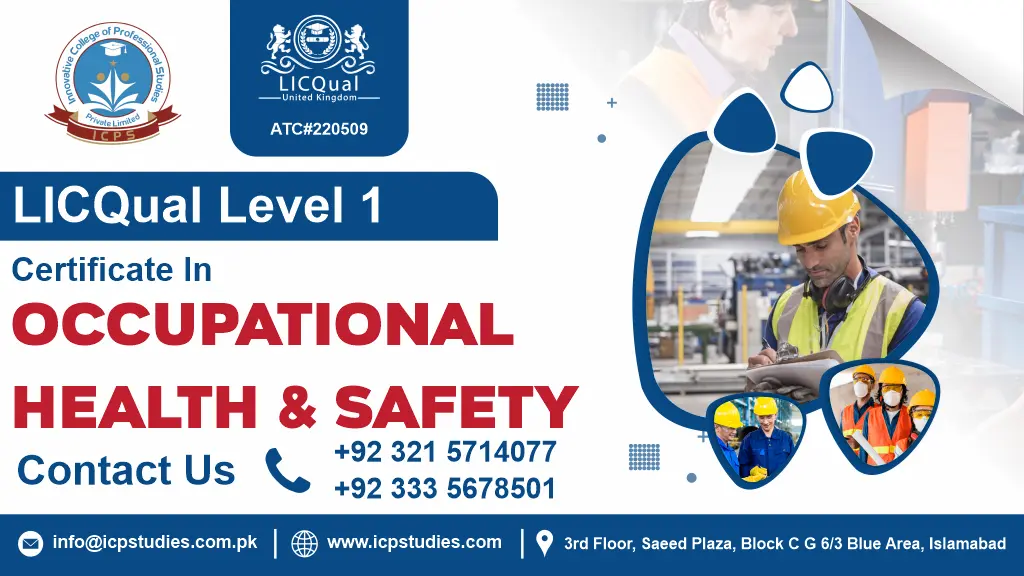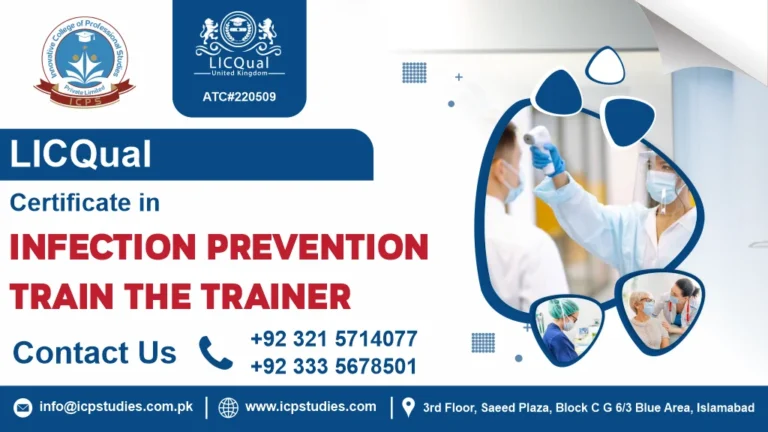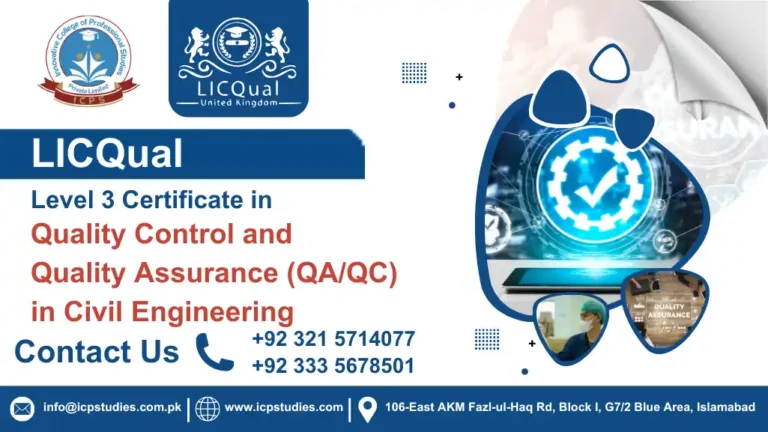In a world where safety is paramount, ensuring the well-being of every individual within a workplace is not just a legal obligation but a moral imperative. Every organization, regardless of its size or industry, needs to prioritize occupational health and safety to foster a secure and productive environment. That’s where LICQual steps in with its comprehensive Introductory Certificate in Occupational Health and Safety (Level 1), your gateway to a safer and healthier workplace.
Our course curriculum is meticulously designed to cover all essential aspects of occupational health and safety, ensuring that participants gain a holistic understanding of workplace hazards and risk management strategies.
Delivered by seasoned professionals with years of experience in the field, our training sessions are engaging, informative, and tailored to meet the diverse learning needs of participants. We believe in learning by doing. Our training methodology incorporates practical exercises and case studies, allowing participants to apply theoretical knowledge to real-world scenarios effectively.
Take the first step towards safety excellence with LICQual’s Introductory Certificate in Occupational Health and Safety (Level 1). Equip yourself and your team with the knowledge and skills necessary to create a safer, healthier, and more productive work environment. Enroll now
All About Introductory Certificate in Occupational Health and Safety (Level 1)
Course Overview
The LICQual Introductory Certificate in Occupational Health and Safety (Level 1) is a comprehensive training program designed to provide participants with a foundational understanding of occupational health and safety principles. This course equips learners with the essential knowledge and skills needed to identify workplace hazards, assess risks, and implement effective control measures to ensure a safe working environment.
Participants gain an understanding of the fundamental concepts and principles of occupational health and safety, including the importance of risk assessment and control.
Participants learn how to conduct risk assessments effectively and implement control measures to mitigate identified risks, thereby minimizing the likelihood of accidents and injuries.
The course emphasizes the importance of fostering a safety-oriented culture within the organization and effective communication of health and safety policies and procedures.
The LICQual Introductory Certificate is suitable for individuals at all levels within an organization, from frontline workers to managers and supervisors. It is particularly beneficial for those with health and safety responsibilities or anyone seeking to enhance their understanding of workplace safety practices.
Upon successful completion of the course and assessment, participants receive a recognized certification from LICQual and demonstrating their competence in occupational health and safety at Level 1. This certification not only enhances individual skills and knowledge but also contributes to creating safer and healthier workplaces, ultimately benefiting both employees and employers alike.
Study Units
Learning Outcomes
Introduction to Occupational Health and Safety
- Understand the fundamental principles of occupational health and safety.
- Recognize the importance of health and safety in the workplace for both individuals and organizations.
- Identify the legal framework and regulatory requirements governing health and safety.
Workplace Hazards
- Identify common workplace hazards such as slips, trips, falls, manual handling, hazardous substances, working at height, and machinery hazards.
- Understand the potential consequences of workplace hazards on individuals and organizations.
- Apply knowledge of workplace hazards to implement preventive measures effectively.
Risk Assessment
- Understand the principles and importance of risk assessment in the workplace.
- Demonstrate proficiency in conducting risk assessments using appropriate tools and techniques.
- Prioritize risks and recommend control measures to mitigate identified hazards effectively.
Control Measures
- Implement control measures to minimize or eliminate identified workplace hazards.
- Differentiate between engineering controls, administrative controls, and personal protective equipment (PPE) and select appropriate measures.
- Monitor and review control measures to ensure their effectiveness in reducing risks.
Safety Culture and Communication
- Recognize the significance of fostering a safety-oriented culture within the organization.
- Effectively communicate health and safety policies and procedures to employees at all levels.
- Encourage employee participation and engagement in safety initiatives to promote a positive safety culture.
Legal Responsibilities
- Understand legal responsibilities related to health and safety in the workplace.
- Identify relevant legislation and regulations, including the Health and Safety at Work Act, COSHH Regulations, and PPE Regulations.
- Ensure compliance with legal requirements and understand the consequences of non-compliance.
By successfully completing the LICQual CIEH Introductory Certificate in Occupational Health and Safety (Level 1) and achieving the outcomes outlined above, participants will be equipped with the knowledge and skills necessary to contribute to creating safer and healthier workplaces. They will understand the importance of proactive hazard identification, risk assessment, and effective control measures, ultimately promoting a culture of safety and compliance within their organizations.
Admission Criteria
The following entry requirements are typically necessary:
- Minimum Age: Participants must be at least 16 years old at the time of enrollment. This requirement ensures that candidates have the maturity and understanding necessary to engage with the course content effectively.
- Language Proficiency: Candidates should have a proficient understanding of the language in which the course is delivered. This ensures that participants can comprehend course materials, actively participate in discussions, and complete assessments successfully.
- Educational Background: There are no specific educational prerequisites for this course. It is open to individuals from all educational backgrounds, including those without formal qualifications. This inclusive approach allows participants from diverse backgrounds to benefit from the training.
- Health and Fitness: While the course primarily focuses on occupational health and safety principles, participants should be in good health and physical condition to engage in practical exercises and activities during the training sessions. Any health conditions that may impact participation should be disclosed to the course provider prior to enrollment.
- Access to Learning Resources: Candidates should have access to the necessary learning resources, including a computer or mobile device with internet connectivity. This allows participants to access course materials, complete online assessments, and engage in virtual learning activities as required.
- Commitment to Learning: Enrollees should demonstrate a commitment to actively participate in the course and complete all required assessments and activities within the stipulated timeframes. This commitment ensures that participants derive maximum benefit from the training and achieve the learning outcomes of the program.
- Legal Requirements: Participants should be aware of and willing to adhere to any legal requirements or regulations related to health and safety in their respective jurisdictions. This includes compliance with any specific industry regulations or workplace policies that may apply.
By meeting these entry requirements, candidates can embark on their journey to acquire essential knowledge and skills in occupational health and safety, ultimately contributing to safer and healthier workplaces for themselves and their colleagues.
Ideal Candidate
This course is suitable for:
- Employees: Frontline workers, supervisors, and managers across all industries who are responsible for ensuring the health and safety of themselves and their colleagues.
- Newcomers to Health and Safety: Individuals who are new to the field of occupational health and safety and are seeking a foundational understanding of principles and practices.
- Safety Representatives: Employees designated as safety representatives or health and safety committee members within their organizations.
- Small Business Owners: Entrepreneurs and small business owners who want to create safe work environments for their employees but may not have formal training in health and safety.
- Career Changers: Individuals considering a career transition into health and safety roles who need to develop basic knowledge and skills in the field.
- Compliance Officers: Professionals responsible for ensuring compliance with health and safety regulations within their organizations.
- Contractors and Consultants: Freelancers, contractors, and consultants who provide health and safety services to organizations and need a recognized certification to enhance their credibility.
- Anyone Interested in Workplace Safety: Individuals who have a personal interest in workplace safety and want to contribute to creating safer and healthier environments for themselves and others.
This course caters to learners at all levels of experience and expertise, providing a solid foundation in occupational health and safety principles. Whether you’re looking to enhance your skills, comply with legal requirements, or improve safety practices within your organization, the LICQual CIEH Introductory Certificate offers valuable insights and practical knowledge to help you achieve your goals.
FAQs about Introductory Certificate in Occupational Health and Safety (Level 1)







